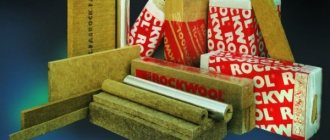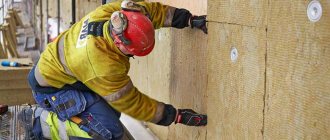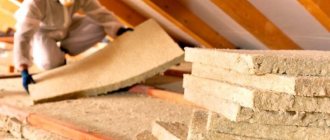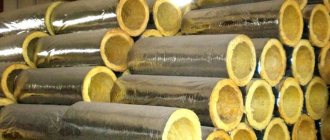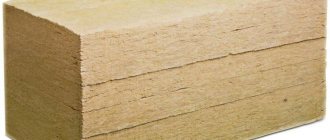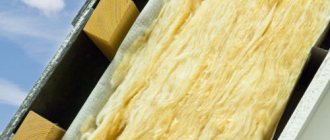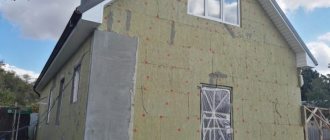Fibrous inorganic materials with the function of thermal and sound insulation form a group of popular insulation materials - mineral wool. The varieties of material representing the group owe their characteristic properties to the raw materials for their production. In the technology for producing stone wool, such defining components are rocks of natural volcanic origin.
It is this composition that increases the durability of the final product and significantly increases its thermal insulation and moisture-repellent properties. It is obvious that such insulation with improved physical and chemical characteristics has become the basis for most energy-saving technologies for many industries and activities.
An assortment of insulation for solving problems of high-quality thermal insulation of various structures
Stone wool production, factory process technology
The English phrase for basalt insulation, when literally translated into Russian, sounds like “mountain wool”. Imagining the appearance of the insulation, and knowing that the raw materials for production are gabbro-basalt rocks, we can agree with this definition.
For the first time, erupted and frozen fibers of volcanic lava, as if whipped and similar to tufts of wool, were found 15 centuries ago. They can be considered the prototype of modern stone (basalt) wool, which was put into production back in 1897 on the American continent. For the average consumer, insulation became available later. In our country, its popularity and stable sales growth have occurred over the past three decades. It's time to find out what the technological process for obtaining “mountain wool” is.
Production: from crushed stone to thermal insulation. Visual diagram of the factory process
Multi-stage technology consists of artificially replicating the complex natural conditions of erupting lava at a plant producing insulation. 1500°C is the temperature of the furnace, into which crushed volcanic stone of the basalt group falls and is brought to a liquid lava-like state.
Basalt is a stone that retains heat
The molten mass flows from the feeder holes into the nozzles of special blowing devices. Compressed air (9 atm.) breaks the jet into small drops, which are given enormous acceleration. Scattering at the exit of the nozzle, the melt particles elongate and, after instant cooling, turn into small thin fibers. This stage of insulation production is well demonstrated in the initial segment of the presented video material:
When depositing the resulting piece fibers, the necessary binder composition is sprayed into the chamber volume to combine all the fibers into a solid “carpet”.
Next, the base of the future insulation is treated with liquid compounds that help increase its vapor permeability, water-repellent characteristics and density. At the next stage, the “carpet” enters the heat treatment chamber, where polycondensation occurs at 200°C. Now the canvas can be cut and sent for packaging.
Cutting fabric into standard slabs
Reviews on the use of ISOVER materials in the construction of houses:
_____________________________________________________________________________________________________
Vitaly Tikhonov, foreman: “My brother and I decided to make a children’s room in our parents’ house on the attic floor. It was a bare frame of the rafter system, where the wind flowed freely. We chose a material based on mineral wool, since it is safe for humans, and this is very important for us, since this is a children's room where our children will be. Working with ISOVER materials is very simple and convenient. It is good to fill the space between the rafters, since due to the elasticity of the insulation, it fits tightly to the structure. After completing the work, we were satisfied with the result: it became more comfortable to be in the room in hot weather, sound insulation increased, and, importantly, the materials we used are non-flammable.”
READ OTHER REVIEWS
__________________________________________________________________________________________________
We hope that we have helped you understand the advantages, similarities and differences between quartz- and stone wool-based mineral wool, understand the main characteristics and properties of mineral wool, and now you can make an objective choice to ensure that your home is always warm and comfortable. Live long in a warm house!
Did you like the article? Share it on social networks.
Chemical composition of stone wool
The raw material for the production of stone wool is predominantly basalt rock and a limited proportion of metamorphic rocks with a similar chemical composition.
Approximate percentage composition of the main components of raw materials for the production of insulation:
- 45-65% – SiO2.
- 10-20% – Al2O3.
- 5-15% – FeO and Fe2O3.
- 7-11% – CaO.
- 5-10% – MnO.
The remaining share comes from oxides of other metals and other substances.
An important indicator of the quality of cotton wool is the ratio between oxides - acidic and basic. The parameter is characterized by the acidity module, with an increase in which the thermal and chemical resistance of the fiber improves, the wool acquires additional water-repellent ability and becomes more durable.
GOST 4640-93 defines types of mineral insulation with a fiber diameter of 6-12 microns based on the acidity modulus:
- Type A – over 1.6.
- Type B – 1.4-1.6.
- Type B – 1.2-1.4.
Products made from smaller diameter fibers are automatically defined as Type A mineral wool.
To obtain a given density and shape, a binder component (usually synthetic) is introduced into the insulation composition during production. In the finished product its mass fraction does not exceed 2%. Moreover, the substance is present in a bound state, so it is inert to the external environment and safe for health.
Note! When creating a single insulating layer, stone wool with different densities is not used.
Why mineral wool is an effective heat and sound insulator
Thermal insulation of mineral wool is based on two elements: the small diameter of its constituent fibers does not allow heat to accumulate; the chaotic internal structure forms many air pockets that prevent the free transfer of radiant heat radiation. Thermal insulation of rigid mineral wool slabs is ensured by the random orientation and arrangement of fibers. By the way, their resistance to dynamic loads will be higher, the greater the percentage of forming fibers located vertically - i.e. Manufacturers of mineral wool boards are forced to find the optimal balance between thermal conductivity and compression resistance.
Sound insulation with mineral wool is achieved due to its air-cellular internal structure - standing sound waves and acoustic noise immediately attenuate, because cannot continue to spread.
Basalt fibers: classification and application of produced types
Basalt fibers are divided into continuous, the length of which can exceed 50 km, and staple fibers - sections of short length. The thickness (diameter) of fibers is measured in millionths of a meter - micrometers (µm). This parameter underlies their classification:
- Microthin - up to 0.6 microns in diameter. These fibers are in demand in the production of fine cleaning devices for various media.
- Ultrathin - thickness range 0.6-1.0 microns. They are used in filters, as well as to produce ultra-light materials with universal insulating properties.
- Super thin – 1-3 microns. Area of application: filters, insulating mats, harnesses. The material does not shrink, its heat resistance is 200°C higher than previous types.
- Thin – 9-15 microns. Popular fibers for industrial insulators and coarse filter products.
- Thickened - 15-25 microns. The main material for filtration in various drainage systems.
- Thick – 25-150 microns. A fabric made of randomly woven fibers, each up to 3 m long, is distinguished by its resistance to tensile forces. The magnitude of the withstanding load can reach 650 MPa (approximately a force of 65 kg applied to each square millimeter of cross-sectional area).
- Coarse – 150-500 microns. In combination with special binder components, such fibers often act as a reinforcing layer.
Basalt fabric is a promising composite material
Staff
Don't skimp on employees. You need competent and highly qualified personnel with experience in a similar field.
Average salaries in the region according to hh.ru:
- Technologist, 1 person – 40,000 rubles
- Locksmith, 2 people - 50,000 rubles
- Equipment adjuster, 1 person – 30,000 rubles
- Loader, 2 people – 40,000 rubles
- Total - 160,000 rubles
The business owner handles bookkeeping and payroll in order to save money. Over time, you can hire an accountant or outsource his services.
Scope of application of basalt (stone) wool
The areas of application of basalt insulation are determined by the unique physical, mechanical and operational properties of the material. The main areas in which stone wool has found application:
- Installation of ventilated facades and insulation of surfaces for final plaster.
- Internal thermal insulation of loggias and balconies, load-bearing walls (if it is not possible to carry out external work).
- Noise and heat insulation of hollow partitions of residential premises and offices.
- Thermal protection of floors, ceilings, attics, roofs.
- Fire protection of communications, engineering structures, load-bearing beams and metal columns.
- Arrangement of baths and steam rooms.
- Thermal insulation of stoves, ovens, ovens.
- Filling of sandwich panels and frame structures.
- Insulation of structures of household and industrial refrigerators.
- Shells for insulating pipelines and ventilation ducts.
Pipe cylinders: mechanical protection and elimination of heat loss
Important! Less dense insulation samples have good elasticity. This quality helps in protecting figured, complex, asymmetrical surfaces and elements of building structures.
ISOVER Warm Roof Strong
To insulate walls, choose a specialized product ISOVER Warm Walls Strong with Formostability technology, which guarantees stability in the structureFor the roof, use the material ISOVER Warm Roof Strong with technology AquaProtect, which provides the material increased moisture resistance Mineral wool creates maximum warmth and comfort in a house or apartment. The material is made from natural components: quartz, soda, limestone. Recommended for use even in medical and children's institutions, because mineral wool is a safe material for human health and the environment.- Maintains a comfortable temperature in the house thanks to the low thermal conductivity coefficient
- Does not require additional fasteners during installation due to high elasticity
- Has enhanced moisture resistance
- Easy to use - already cut into slabs for standard frame spacing
- Safe for human health and the environment
- Belongs to the group of non-combustible materials (NG)
- Features enhanced moisture resistance thanks to AquaProtect technology
- Reliably fixed in the frame without creases or slipping due to the high elasticity of the material
- There is a minimum of waste when insulating a roof with different rafter pitches
- It is convenient to cut the roll into the required sizes thanks to special markings on the packaging
- Safe for human health and the environment
- Belongs to the group of non-combustible materials
- Pitched roofs and attics
- Insulation of walls from the inside
- Insulation of walls from the outside: insulation under siding/cladding/cladding bricks
- Frame walls
- Insulation of balconies and loggias
- Pitched roofs and attics
- Insulation of walls from the inside
- Insulation of walls from the outside: insulation under siding/cladding/cladding bricks
| Parameter | ISOVER Warm Walls 50 mm. | ISOVER Warm Walls 100 mm. | ISOVER Warm Roof 50 mm | ISOVER Warm Roof 100 mm | ISOVER Warm Roof 150 mm |
| Mineral wool thickness, mm | 50 | 100 | 50 | 100 | 150 |
| Mineral wool width, mm | 610 | 610 | 1220 | 1220 | 1220 |
| Mineral wool length, mm | 1000 | 1000 | 4100 | 4100 | 4100 |
| Quantity per package, m2 | 6,1 | 3,05 | 10 | 5 | 4,88 |
| Quantity per package, m3 | 0,305 | 0,305 | 0,5 | 0,5 | 0,735 |
| Quantity per package, pcs. | 10 | 5 | 2 | 1 | 1 |
| Thermal conductivity at temperature (10±2)0С, λ10, no more (W/(m•K), GOST R 31924 | 0,034 | 0,034 | 0,034 | 0,034 | 0,034 |
| Flammability group, GOST 30244-94 | NG | NG | NG | NG | NG |
Advantages of stone wool (basalt insulation)
The listed advantages relate directly to insulation made from basalt fibers:
- The service life of the insulating material exceeds 50 years.
- The insulation is not afraid of the following influence factors: ultraviolet rays, temperature changes, humidity, aggressive chemical compounds and substances, technical oils, fungus, bacteria, rodents, insects.
- The low thermal conductivity of the insulation is explained by the chaotic structure of the stone fibers, the volume of which is limited by the size of the slab. The entire space between the fibers is filled with static air, and it practically does not participate in heat transfer. Thanks to these features, basalt wool perfectly retains the heat of interior spaces in cold weather and prevents them from quickly warming up in hot weather.
- Vapor permeability is a very important positive property of stone insulation. Through the thickness of the fiber material, excess moisture and condensation, which can destroy the material of insulated surfaces, are easily removed and evaporated.
- The basalt heat insulator material does not burn, inhibits the spread of fire, and can withstand enormous heat (over 1000°C) without destroying the structure or releasing asphyxiating or toxic substances.
- A significant range of possible material densities facilitates the task of selecting slabs of a certain rigidity and strength to solve specific problems.
- Ecological purity of natural raw materials and materials produced from them.
- Versatility. The previous section with a list of the main areas of application of the material speaks about this quality of basalt insulation.
- Additional creation of acoustic comfort in rooms that were insulated with basalt wool.
- Variety and availability for consumers of cotton wool of various densities, release forms, purposes, linear dimensions and thickness.
- Convenient storage, transportation and loading of lightweight material. Easy cutting and installation work for performers without sufficient experience.
The fire safety of insulation has been proven by tests and practice.
Useful information! Electrical insulating and dielectric properties are characteristic of fibers made from basalt stones. Therefore, products made from them are “transparent” to magnetic fields and radiation of any nature.
The main qualities for which professional builders and private developers choose stone insulation are demonstrated in the video:
How to advertise a business
Your own business card website, publishing ads on free websites and advertising in specialized publications are the main ways to advertise your products.
The most optimal of them is your own website. There you can display all the necessary information and set your target. The minimum costs for website development start from 10,000 rubles, for advertising - about 15,000 rubles, depending on the circumstances.
Well-known manufacturing companies
Among the suppliers of mineral wool of this type, several large companies stand out. Their competition, the desire to constantly improve quality and not inflate the cost of goods, only benefits the potential consumer.
Mineral wool TechnoNIKOL
An example of the quality of a domestic product that has entered the international market. The brand's network of representative offices includes more than three dozen countries. Options for manufactured products belong to several lines: private and professional construction, fire protection options, technical insulation.
The most popular domestic brand of insulation
Basalt wool Knauf
The production of stone insulation is only one of the lines of materials, finishing and complex systems produced by the company. But the quality of the produced insulation does not suffer from this, and the offered range helps to solve any problem.
Rockwool products
The Danish brand is famous for the quality of its product brands. Of the company’s 28 factories, 4 production complexes in the Russian Federation operate for Russian consumers. Rockwool's assortment includes several series of products for various purposes: insulation for roofs, facades, apartments and buildings, fire protection, noise reduction, insulation of engineering systems, oil and gas complex structures.
Other manufacturers of insulating materials made from basalt fibers - Ecover and ISOROC - are not lagging behind in the struggle for buyers. The first young enterprise is located at the source of raw materials (in the Urals) and is rapidly progressing. And the Tambov plant of the ISOROC company, after large-scale modernization, guarantees product compliance with industry and world standards.
Proven technology and the latest generation industrial equipment make it possible to produce highly efficient mineral heat insulators that reliably insulate any surfaces and laid communications. Stone wool made from basalt rocks helps to obtain a higher level of protection. If you need to provide a class of thermal insulation protection that meets the most stringent standards, you need to pay attention to this material.
Which equipment to choose
Purchasing equipment is the most expensive thing when opening a workshop. Technical equipment must be of high quality, since this will directly affect the production of the finished substance.
To produce mineral insulation, the following equipment is required:
- conveyor for moving raw materials;
- melting furnace;
- centrifuge;
- fiber deposition chamber;
- corrugating or lamellar machine;
- pumps;
- heat treatment and polymerization chamber;
- circumcision station;
- stacking equipment;
- packaging machine.
Such equipment can be purchased and prepared within 4 months. The approximate price for the above equipment will be about 10,000,000 rubles. It is quite expensive, but during the initial start-up there is an option to rent semi-automatic equipment. Once sales channels have been established, you can switch to more powerful and fully automatic mechanisms.
Installation methods
Mineral wool slabs are installed in two ways: dry and wet . The first involves laying slabs in the gap between the wall and the sheathing. For this, a wooden or metal frame is created. The insulation is laid in the spaces between the profiles. The wet method is gluing slabs onto the wall surface, followed by applying a primer and mesh reinforcement. Installation of mineral wool cylinders is carried out using self-adhesive tape or thin wire.
Advantages and disadvantages of mineral wool
Benefits include:
- Low thermal conductivity, which makes it an excellent insulation material
- Fire safety
- Resistant to temperature changes. The material does not deform when heated/cooled
- Chemical and biological stability
- Excellent vapor permeability, making the material “breathable”
- Easy to install
Flaws:
- Requires treatment with water-repellent agents to reduce moisture absorption. When moisture is absorbed, the thermal insulation properties decrease and cold bridges form.
- Large mass compared to foam, which increases the cost of delivery of the material
